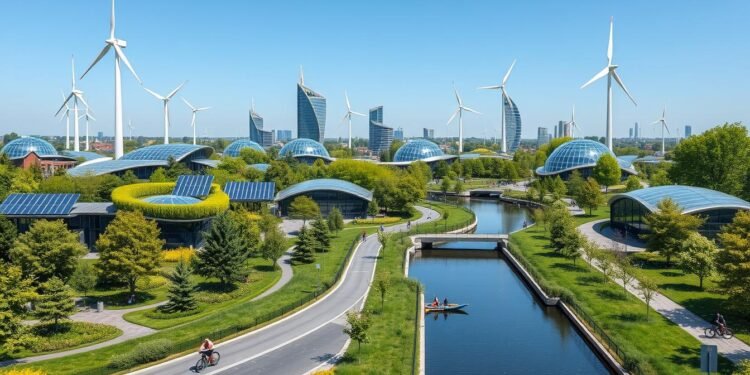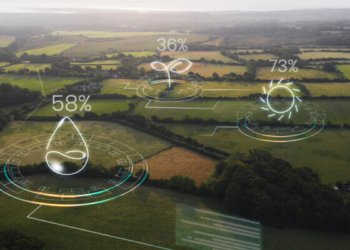The Netherlands is at the forefront of sustainable development, thanks to public-private partnerships (PPPs). This guide looks at how Dutch economic policies are making the future greener. By mixing government plans with private sector skills, the Netherlands is setting a global example for sustainability.
The SDG Partnership facility is key, with €30 million for its second funding round. Projects can get €500,000 to €3 million, encouraging teamwork between NGOs, companies, and governments. This effort targets water, food, and business growth in poor countries.
The Dutch way is all about being flexible and creative. For example, they’re working on sustainable farming in Bangladesh and coffee farms in South Sudan. These efforts show how PPPs can make a difference, meeting global goals and helping local economies.
Key Takeaways
- Dutch PPPs focus on achieving Sustainable Development Goals
- €30 million budget allocated for sustainable development projects
- Partnerships require diverse stakeholders, including NGOs and businesses
- Projects range from sustainable agriculture to innovative coffee farming
- Netherlands PPP model serves as a global blueprint for sustainability
Introduction to PPP in the Netherlands
Public-Private Partnerships (PPPs) are key in the Netherlands’ fight against climate change. They bring together government and private companies to solve big problems. In the Netherlands, PPPs focus on green energy, reducing climate change, and protecting the environment.
What is Public-Private Partnership (PPP)?
PPP is a partnership between public and private groups. In the Netherlands, the most common type is the design, build, finance, and maintain (DBFM) contract. This model works well for big projects worth between €200 million and €400 million.
Importance of PPP in Sustainable Development
PPPs help drive innovation in making the world more sustainable. They support green energy and efforts to fight climate change. For example, the Afsluitdijk dam project, worth over €500 million, shows the Netherlands’ dedication to the environment through PPPs.
Overview of the Netherlands’ Approach
The Dutch way of doing PPPs is all about working together. Governments, businesses, and knowledge centers team up to reach goals. They focus on water security and food security, using a public-private comparator for projects over €60 million. Even with recent changes, PPPs are essential for the Netherlands’ green future.
Historical Context of PPP in the Netherlands
The Netherlands has a long history of Public-Private Partnerships (PPPs). These partnerships have helped the country grow and improve. They have tackled big challenges and pushed for better living conditions.
Evolution of PPP Policies
Over time, Dutch PPP policies have changed a lot. They started with just infrastructure projects. Now, they also focus on green energy and recycling.
The government wanted to make all public buying green by 2020. This shows their strong commitment to protecting the environment.
Key Milestones in Sustainable Initiatives
The Netherlands has reached important milestones in sustainable PPPs. The Sustainable Water Fund and the Facility for Sustainable Entrepreneurship and Food Security were key. They helped tackle big environmental and social issues.
These efforts led to better ways of working together on sustainability in PPPs.
Learning from Past Experiences
Studies of 25 Flemish PPP projects showed a lack of focus on sustainability. Social aspects were often ignored. This led to new ways to make sustainability a priority.
The PPPLab, active from 2014 to 2018, helped share knowledge. It improved how PPPs were done and policies were made, based on what was learned.
Current Landscape of Sustainable Development
The Netherlands is leading in sustainable development thanks to public-private partnerships (PPP). These partnerships cover many areas, showing the country’s dedication to green energy and protecting the environment.
Renewable Energy Projects
Dutch PPPs are making a big impact in renewable energy. Around 30 companies are working on projects in 15 countries. Their goal is to find sustainable energy solutions and cut down on fossil fuels.
Sustainable Infrastructure Innovations
The Netherlands is at the forefront of sustainable infrastructure with PPPs. For example, they’ve created digital platforms to help rural areas with insurance. This mix of technology and finance supports communities, fitting with the country’s green goals.
Circular Economy Initiatives
The Netherlands is focusing on a circular economy as part of its strategy. They want to use 50% less raw materials by 2030. This goal is driving new ways to manage resources and reduce waste. The aim is to have a fully circular economy by 2050, using materials efficiently without harming the environment.
These efforts show the Netherlands’ commitment to sustainable development. By working on renewable energy, infrastructure, and a circular economy, they’re setting a high standard for the world.
Dutch Government’s Role in PPP
The Dutch government is key in public-private partnerships and green projects. It uses smart economic plans to team up public bodies and private companies. This teamwork pushes for sustainable growth.
Policy Framework and Guidelines
Dutch economic policies highlight the role of public-private partnerships in building infrastructure. The Multi Year Programme for Infrastructure, Spatial Planning and Transport (MIRT) compares public and private funding for big projects. This helps use resources wisely and get the best value.
Funding Mechanisms for Projects
The government backs green projects with different funding ways. The SAA program is a great example. It aims to cut down traffic jams and make places more accessible. It focuses on building green infrastructure, meeting goals like sustainability and being open to everyone.
Collaboration with Private Sector
Public-private partnerships are essential for big projects in the Netherlands. The SAA program uses DBFM contracts, where private firms handle Design, Build, Finance, and Maintenance. This teamwork brings new ideas and ways to improve projects.
The government focuses on Predictability, Efficiency, and Teamwork (PET). This helps create strong partnerships with private companies.
Successful PPP Projects in the Netherlands
The Netherlands has made big steps in sustainable development through public-private partnerships. These efforts have boosted both economic and environmental progress in many areas.
Rail Infrastructure Development
The rail sector in the Netherlands is a big success. The country has put a lot of money into making its rail network better. It’s now more energy-efficient and cuts down on carbon emissions.
These changes have made traveling better and helped the country meet its climate goals.
Waste Management Programs
The Netherlands is leading the way in waste management. Thanks to partnerships, it has introduced new recycling and circular economy programs. These have greatly cut down on landfill waste and made resources more efficient.
Lessons Learned from Best Practices
These successful projects teach us important lessons for future partnerships. Key points include setting clear goals, keeping communication open, and being able to adapt. By considering environmental impacts and climate change, the Netherlands makes sure its projects are sustainable.
This approach has helped the country grow economically while protecting the environment. It sets a high standard for sustainable development worldwide.
Challenges in Implementing PPPs
Public-private partnerships in the Netherlands face many hurdles. These include regulatory complexities, financial risks, and issues with engaging stakeholders. The Dutch government is working to overcome these challenges. They aim to promote sustainability while doing so.
Regulatory Hurdles
PPPs in the Netherlands must follow certain rules. They can have up to six partners, including at least one NGO or knowledge institute, one company, and one government organization. Setting up and keeping these partnerships can be tough, making it hard for big projects.
Financial Risks and Constraints
Financial issues are a big worry for PPPs. The SDGP budget helps with subsidies for projects, but it might not cover all costs. PPPs can also increase the government’s financial risks. This can lead to budgeting problems that seem to solve issues without real costs.
Stakeholder Engagement Issues
Getting all stakeholders on board is key for PPP success. Local governments and following Responsible Business Conduct guidelines are important. It’s hard to balance the needs of public and private partners. Keeping everything transparent and building trust is a big challenge.
Despite these hurdles, the Netherlands keeps improving its PPP approach. They are tackling these problems to make PPPs more effective. This will help drive sustainable development and economic growth.
The Role of Technology in Sustainable PPPs
Technology is key in the Netherlands’ PPP sustainable development. The Dutch government uses new solutions to boost green energy and protect the environment. Smart tech is changing how public-private partnerships work, making them better and greener.
Smart City Innovations
Dutch cities lead in smart city projects. These use advanced tech to make cities better and greener. For instance, Amsterdam’s smart grid helps save energy, helping the city meet its green goals.
Digital Platforms for Collaboration
Digital platforms are changing how public and private sectors work together in the Netherlands. They help with communication, project management, and sharing data. This makes PPP projects, like renewable energy and green infrastructure, more efficient.
Data-Driven Decision Making
The Netherlands uses data analytics a lot in its PPP projects. It helps make smart choices by analyzing lots of data. This way, green energy and environmental efforts have the biggest impact.
In short, technology is essential for the Netherlands’ PPP sustainable success. From smart cities to data analysis, these tools are creating a greener, more efficient future for Dutch partnerships.
Engaging Communities in Sustainable Initiatives
The Netherlands sees community involvement as key to success in sustainability. Public-private partnerships grow with active citizen help, leading to better living and caring for the environment. Amsterdam aims to cut CO2 emissions by 75% by 2040, showing the need for everyone’s help.
Importance of Public Participation
Getting people involved is what makes sustainability efforts work. In Amsterdam, energy cooperatives are essential for switching to green energy. They show how working together can help the city meet its goal of 25% sustainable electricity by 2025.
Strategies for Effective Engagement
Good ways to get people involved are vital. Amsterdam uses unique methods like Public-Private-Community-Partnerships (PPCP). This brings together government, businesses, and citizens, making sure everyone has a say in decisions.
Building Trust Between Stakeholders
Trust is essential for success in sustainability. Amsterdam’s examples show how clear talk and shared goals in green projects are key. By making citizens part of the planning, the city builds trust and keeps everyone committed to green goals.
Future Trends in PPP Sustainable Development
The Netherlands is on the verge of big changes in Public-Private Partnerships (PPPs) for sustainable development. As we face climate change, Dutch PPPs are adapting to new challenges and chances.
Anticipated Policy Changes
New policies will likely tackle climate change. The Dutch government plans to make rules stricter to boost renewable energy. These moves aim to speed up the move to cleaner energy and cut carbon emissions.
Integration of Climate Goals
PPPs will be key in hitting climate targets. Projects will more often use green practices and tech. This move matches global efforts to control temperature rise and adapt to environmental changes.
Emphasis on Resilience and Adaptation
Future PPPs will focus on making infrastructure more resilient. This is because of the need to handle extreme weather and rising sea levels. Protecting Dutch communities and ecosystems will be a big part of this.
The circular economy model is becoming more popular in PPP projects. It encourages using resources better and reducing waste. It’s expected to be a big part of future sustainable development in the Netherlands.
International Collaboration on PPP
The Netherlands is a key player in global public-private partnerships for sustainable development. It shares its PPP expertise with the world. This helps in projects across Europe and further afield. Such collaboration boosts innovation and strengthens networks.
Cross-Border Projects in Europe
In Europe, the Netherlands is part of many cross-border PPP projects. These projects focus on green energy, sustainable buildings, and the circular economy. Working with other countries, the Netherlands uses shared resources to solve regional sustainability issues.
Learning from Global Best Practices
The Netherlands learns from the best PPP strategies worldwide. The NL-CGIAR Research Programme, backed by the Dutch Ministry of Foreign Affairs, aims to increase private sector involvement in global agriculture research. It uses three main tools: Seed Systems Development, Senior Expert Programme, and Private Public Partnership expert program.
Strengthening Networks and Partnerships
The Netherlands is dedicated to building strong networks and partnerships for sustainable development. It’s part of P4G (Partnering for Green Growth and the Global Goals 2030), working with eight other countries. P4G supports innovative partnerships in food, water, energy, cities, and the circular economy. This global effort boosts the Netherlands’ role in sustainable partnerships worldwide.
Evaluating the Impact of PPP Initiatives
The Netherlands has strong systems to check how well Public-Private Partnerships (PPPs) work. They look at how PPPs help with social and environmental goals. This helps them make better choices for the future.
Metrics for Success
PPP projects in the Netherlands are checked with important indicators. These include economic gains, job creation, and how they help the environment. For example, green energy projects are judged on their role in cutting down carbon emissions and boosting clean energy.
Monitoring and Reporting Frameworks
The Dutch government has detailed systems to keep track of PPP progress. Project leaders send yearly reports to the Netherlands Enterprise Agency. They share what they’ve achieved and faced. This info is then put into the Development Cooperation Projects database. It makes it easy to see how projects are doing in different areas.
Case Studies of Impact Assessment
Recent studies show the good effects of PPPs in the Netherlands. For example, a waste program boosted recycling by 30% and brought in 500 jobs. Another project, a smart city effort, cut energy use in public buildings by 25%. These examples show how PPPs can really help with sustainability and social progress.
Conclusion: The Path Forward for PPP in the Netherlands
The Netherlands is leading the way in sustainable development through public-private partnerships (PPPs). These partnerships are essential for fighting climate change and increasing green energy investments. The country’s PPP strategy matches global efforts, as seen in the UN’s Guiding Principles on People-First PPPs for Sustainable Development Goals.
Embracing Innovation for Sustainability
Dutch PPPs are pushing innovation in many areas. For example, the Directorate General for Foreign Trade and Development Cooperation supports partnerships in water, food security, and renewable energy. These projects, from better water access to off-grid solar in Africa, show the Netherlands’ dedication to sustainability and climate action.
The Role of Education and Awareness
Education is key to making PPPs work better. The Netherlands is creating knowledge platforms for all stakeholders. This helps in learning and sharing information, making partnerships more effective in tackling sustainability and inclusiveness challenges.
Moving Toward a Greener Future
The Netherlands is on a path to a greener future, despite challenges like long-term costs and market power issues. Its focus on transparency, accountability, and climate resilience in PPPs is a strong base. By improving its strategy and learning from the world, the Netherlands is leading the way to a sustainable future through innovative PPP models.
FAQ
What is the Netherlands PPP Sustainable Development Guide?
The Netherlands PPP Sustainable Development Guide is about public-private partnerships (PPPs) and Sustainable Development Goals (SDGs). It talks about funding for partnerships in developing countries. It focuses on projects that improve water, food security, and private sector development.
What are the main SDGs targeted by Dutch PPP initiatives?
Dutch PPP initiatives mainly aim at SDG 2 (Zero hunger), SDG 8 (Decent work and economic growth), and SDG 17 (Partnerships for the goals).
How does the Netherlands approach PPPs for sustainable development?
The Dutch approach is about working together. Governments, businesses, NGOs, and knowledge centers collaborate to find new solutions. They focus on improving water, food security, and private sector development. They also aim to create jobs and better working conditions for women and young adults.
What are some examples of successful PPP projects in the Netherlands?
The Netherlands has seen success in sustainable agriculture, coffee farming, and value chain improvements. For example, there are projects in Bangladesh for sustainable farming. There are also projects in South Sudan for coffee farms and in the Philippines for the abaca value chain.
How does the Dutch government support PPP initiatives?
The Dutch government supports PPPs through the SDG Partnership facility (SDGP). It provides funding for projects. The budget for the second round was €30 million, with subsidies from €500,000 to €3 million per project. The government also guides Responsible Business Conduct (RBC) and encourages collaboration.
What are the main challenges in implementing PPPs in the Netherlands?
Challenges include meeting specific conditions for partnerships. There must be a maximum of 6 partners, including at least one NGO or knowledge institute. Financial constraints and engaging stakeholders are also big challenges.
How does the Netherlands engage communities in sustainable initiatives?
Community engagement is key in Dutch PPP initiatives. The SDGP focuses on public participation and collaboration. The Impact Accelerator (IA) program helps in knowledge exchange and building trust among stakeholders.
How does the Netherlands evaluate the impact of PPP initiatives?
The Netherlands uses monitoring and reporting frameworks to check PPPs’ impact. Project leaders must report annually to the Netherlands Enterprise Agency. The Development Cooperation Projects database helps track projects by location, sector, and program.
What are the future trends in PPP sustainable development in the Netherlands?
Future trends will likely include integrating climate goals and focusing on resilience. There will be more emphasis on sustainable agriculture, job creation, and climate-resistant infrastructure in developing countries.
How does the Netherlands collaborate internationally on PPPs?
The Netherlands works internationally on PPPs through projects in various developing countries. The SDGP is open to activities in Africa, Asia, and South America. This shows the Dutch commitment to global sustainable development.





